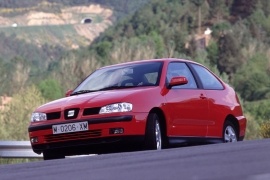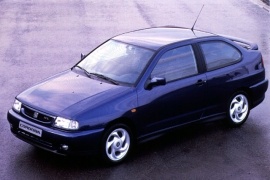SEAT Cordoba SX Models/Series Timeline, Specifications & Photos
First production year: 1996
Engines: Gasoline, Diesel
Body style: Coupé (two-door)
SEAT introduced the Cordoba coupe in 1996, and three years later, along with the final facelift of the range, the Spanish carmaker unveiled the SX version.
Volkswagen launched the Cordoba in 1993 as the three-box sedan version of the Ibiza. The German carmaker introduced both of them in the same year, but it took it another three years to show Cordoba's coupe version. In 1999, along with the rest of the range, SEAT came with a facelift for the entire Cordoba range, including the coupe, also known as SX.
With the facelifted version, the Cordoba received new headlights that incorporated the turn signals. Its slightly wider fenders, both front and rear, enhanced the sporty-looking coupe. Despite its very short trunk lid, it was not a hatchback. The taillights were also changed and featured a clear lens for the reversing lights instead of the smoked one from the 1996 model-year.
Inside, SEAT insisted on showing some sporty accents and installed red letters on the instrument panel, but they used a black background instead of white. The carmaker piled up on the center stack the HVAC controls, the radio-cassette player, and, on top of them, a pair of vents.
Under the hood, SEAT offered the Cordoba coupe with better engines than the regular Ibiza or Cordoba and started with a 75 hp, 1.6-liter engine. The top of the range model, named Cordoba Cupra, was powered by a turbocharged 1.8-liter engine and provided 180 hp. All versions were paired to a five-speed manual gearbox and front-wheel drive.
Volkswagen charged the market with this Spanish-branded three-box coupe in 1996 and offered the small-segment a tough challenge.
In 1996, SEAT introduced a two-door version for its three-years-old Cordoba small-segment sedan. While most carmakers just used hatchbacks for their sportier, three-door vehicles, the Spaniards considered that a trunk in the back wouldn't spoil the car's abilities and will improve its usability. Moreover, the carmaker entered into the World Rally Championship with the Cordoba WRC based on this two-door sedan version. It didn't win, but it made the carmaker famous.
The Cordoba Coupe showed a similar front fascia with the rest of the range. It used the same headlights and grille, but from there on, the differences started to pile up. First of all, since it sported just two doors, they had to be longer to make room for the rear passengers to enter. In the back, the carmaker installed wider windows. At the back, the carmaker offered an option for a wing on the trunk.
Inside, SEAT insisted in showing some sporty accents and installed red letters on the instrument panel, but they used a black background instead of white. The carmaker piled up on the center stack the HVAC controls, the radio-cassette player, and, on top of them, a pair of vents. For the seats, SEAT chose regular Ibiza three-door ones, without too much bolstering.
Under the hood, SEAT offered the Cordoba coupe with better engines than the regular Ibiza or Cordoba and started with a 75 hp, 1.6-liter engine. Top of the line was a 2.0-liter, naturally aspirated gasoline engine that offered 150 hp. All versions were paired to a five-speed manual gearbox and front-wheel drive.

